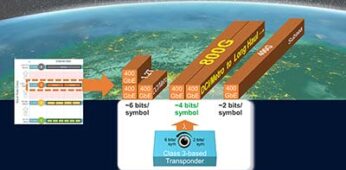Jimmy Yu from Dell’Oro called Optical Fiber Communication Conference (OFC) 2023 “the Terabit Era” and the event highlighted trials and announcements around new 1.2 Terabits per second (T) coherent modules such as Acacia’s Coherent Interconnect Module 8 (CIM 8), the first pluggable 1.2T coherent optical module.
At the same time, network operators are adopting higher speed interfaces. Since last year’s conference, we’ve continued to see the aggressive ramp of 400 Gigabits per second (G) pluggables as they’ve made their way into new markets and applications. While coherent pluggables have been migrating towards shorter reaches for quite some time, customers are now increasingly interested in using them for long-haul applications traditionally serviced by embedded coherent modules. While the high-performance embedded market continues to be strong today, we expect the trend towards pluggables to continue in the future as service providers take advantage of their low power, small size and performance wherever they can. Standards bodies are looking to define both 800G and higher performing 400G interop modes for next generation MSA pluggable optics.
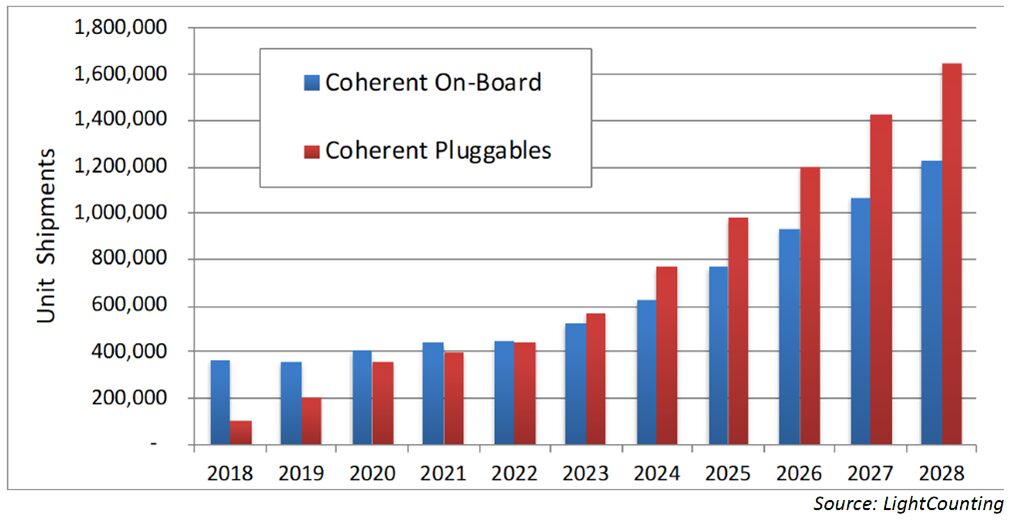
Coherent pluggable ports are expected to exceed embedded ports in 2023.
Acacia had the honor of participating in 13 sessions and 2 interoperability demonstrations at this year’s OFC. Below is a recap of three of the sessions presented in the Market Watch Theater that reinforce the trends toward higher speed interfaces and expected transition from embedded modules to pluggables including industry standardization advancements.
OIF Panel: Defining 800ZR and 800LR; An OIF Update
Tom Williams, Acacia’s Sr. Director, Technical Marketing, gave an Optical Interoperability Forum (OIF) update on 800ZR and 800LR standardization progress. Tom highlighted the rapid success that has been achieved with 400G pluggables and what’s happening next in the standards bodies.
400G Developments Continue
The 400G developments continue in three areas. The first is ongoing deployments of high transmit power 400G ZR+ QSFP-DD pluggables that support OpenZR+ and Open ROADM modes. These modules expand the use cases for 400G QSFP-DD pluggables to metro and regional ROADM networks and enable increased transponder density in transport equipment. The second is 400G ER1 which targets 40km point-to-point applications. The third area is standardization and development of 400G long-haul.

800G Standardization in Progress
The current focus of standardization is on 800LR/ZR and Open ROADM products. Network operators are looking for higher baud rate pluggables to take advantage of improvements in cost and power. Increasing baud rates has become an efficient way to enable more cost-effective optical networks by reducing the number of optics needed to support a given transmission capacity.
Focusing next on 800ZR standardization, Tom highlighted how these considerations are like 400ZR, but different. While 800ZR has the potential for more varied use cases depending on the network operator, some are waiting for 1.6T solutions. The key assumptions are that 800ZR will include 16QAM modulation at 118Gbaud, which is double the 400ZR baud rate. On the receiver side, Open Forward Error Correction, or oFEC, has been selected for improved Optical Signal to Noise Ratio (OSNR) sensitivity and the minimum input power is higher at 118Gbaud. On the transmitter side, there is recognition that the 400G market now includes both amplified and unamplified configurations and co-existence with 400ZR on the same line system requires 3dB higher transmit power for 800ZR. Tom also highlighted three different transmitter power ranges that have been proposed with each option having use cases that bring value to the market. These include:
- -11 to -14dBm: Lowest Cost
- -7 to -11dBm: Co-exist with 400ZR
- 0 to -7dBm: Co-exist with traditional DWDM
800G and Beyond Pluggable Coherent – Building on the Success of 400G
Torben Nielsen, Acacia’s Product Line Manager, Pluggable Modules and Distinguished Engineer, also kicked off his presentation by highlighting the 400ZR/ZR+ success story. As the fastest ramping coherent technology to date, these modules benefitted greatly from the work done early on with industry standards.
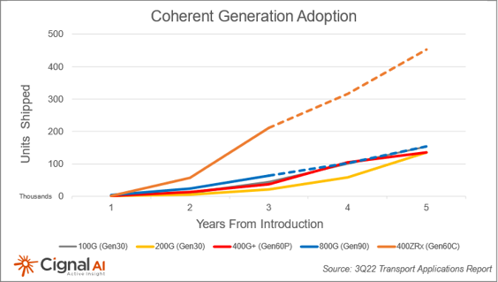
Standardization and Vendor Interoperability
Standardization of optical networking technology helps network operators by providing simplicity, interoperability and volume-driven cost. Torben explained that, in the 400G pluggable market, standardization started with 400ZR and quickly evolved as carriers demanded higher performance. This led to the creation of both the Open ROADM and OpenZR+ MSAs. As a result, today we are seeing 400G pluggables being used across a wide range of applications, using the same component technology throughout each form factor.

Torben also discussed how 400ZR/ZR+ leveraged advancements in co-packaging and how these developments are now being extended to future product development using the same common platform that leverages silicon photonics. For example, the same packaging technology that Acacia used in its highly successful 400G pluggable products is now being utilized in its CIM 8 module, which is enabling a pluggable performance optimized solution operating up to 140Gbaud. Acacia will continue leveraging this same approach for future generations such as 800G and 1.6T modules.
800G Coherent Pluggables
Torben next shared how the industry is already looking ahead to 800G pluggables, with first deployments expected in 2024. Currently, 800ZR/LR is being defined in OIF, as Tom shared in his OIF update, with 118Gbaud 16QAM modulation. 800ZR+ will need standardized media interface specification which will likely be 131Gbaud PCS modulation. Acacia’s silicon photonics can support all transmission rates proposed for both 800ZR and 800ZR+. The high transmit power version can be supported similar to the 400G Bright ZR+ high transmit (TX) power pluggable module.

1.6T Coherent Pluggables
In terms of 1.6 coherent pluggables, Torben suggested they are likely needed in the 2025 timeframe or later. He believes 240Gbaud single carrier pluggable is feasible and can have the best potential cost structure with fewer optical components than multi-carrier approaches. There are several engineering challenges to overcome when developing these products including signal integrity, power and thermal design, but the industry has a great track record when it comes to overcoming these challenges.
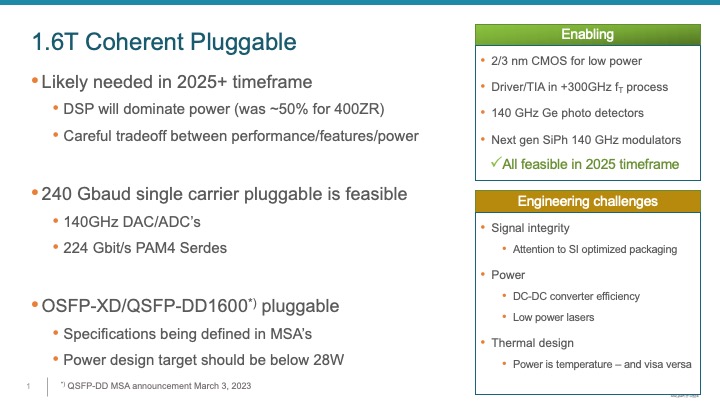
Market Watch Panel IV: Performance-Centric Long Haul
Anuj Malik, Acacia’s Director, Product Management & Strategy, gave an overview of performance-centric coherent modules. The primary goal of these modules has been to help reduce CapEx and OpEx for network operators. Transceiver cost per bit and number of regenerations are the key CapEx drivers. Power, footprint and manageability are the key OpEx drivers.
Key to these solutions has been the development of features such as probabilistic constellation shaping (PCS), adaptive baud rate, and advanced compensation algorithms. These technology innovations give service providers unprecedented transmission flexibility to match their network’s architecture, optimize fiber utilization, and simplify deployment.
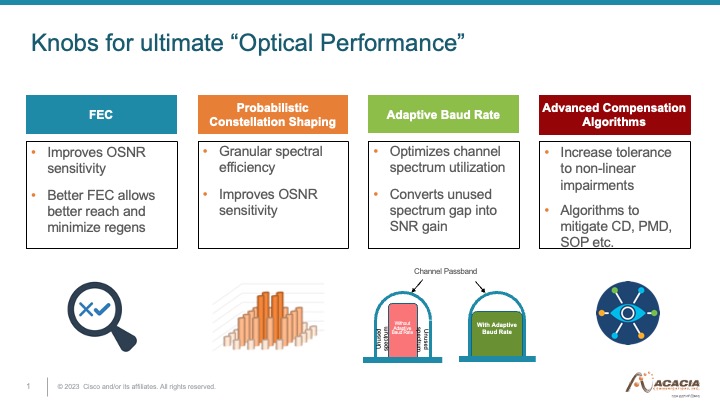
Anuj also discussed the implications of approaching the Shannon limit, where spectral efficiency gains are only incremental. The focus has been on reducing cost, power and footprint. This will require doubling the baud rate with every generation, designing efficient network architectures and leveraging the benefits of silicon photonics and advanced packaging techniques that can be leveraged across multiple generations of products.
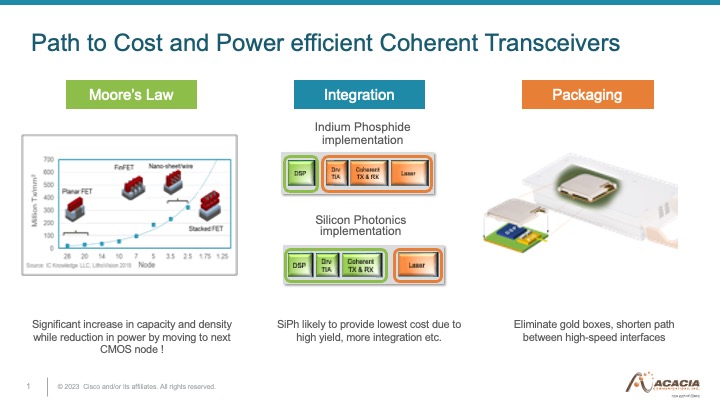
As mentioned earlier, these “terabit era” products were highlighted at this year’s OFC, led by Acacia’s CIM 8 module, with field trials having been announced by China Mobile, NYSERNet and Windstream Wholesale. By leveraging common development approaches with the 400G pluggable modules and Acacia’s proprietary DSP algorithms, the operational benefits of pluggability were brought to the performance-centric multi-haul market segment. Acacia believes the industry may continue migrating performance-centric towards pluggable modules to take advantage of high performance and power efficiency. This may include the development of high performance 400G long haul pluggables and 800ZR+ with up to 131Gbaud.


